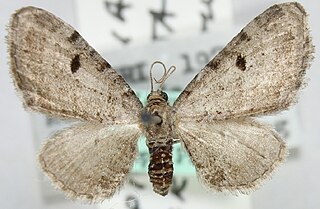
The lime-speck pug is a moth of the family Geometridae. It is a common species throughout the Palearctic region, the Near East and North Africa.

The juniper pug or juniper looper is a moth of the family Geometridae. The species was first described by Michael Denis and Ignaz Schiffermüller in 1775. It is found throughout the Palearctic and in the Nearctic.

Eupithecia actaeata is a Eurasian species of moth of the family Geometridae.

Eupithecia jezonica is a moth in the family Geometridae. It is found in Asia, including India and Nepal. It has also been recorded from Kazakhstan, the Russian Far East and Korea, Japan and Taiwan.

Mesoptila melanolopha is a moth in the family Geometridae first described by Charles Swinhoe in 1895. It is found in Nepal, China, Korea, Japan, Taiwan, India, Sri Lanka, Thailand, Vietnam, Malaysia and on Java, Bali and Borneo.

Eupithecia nuceistrigata is a moth in the family Geometridae. It is found in Taiwan.

Eupithecia taiwana is a moth in the family Geometridae. It is found in Taiwan.

Eupithecia breviculata is a moth of the family Geometridae. It is found in the Mediterranean region, Switzerland, Hungary, the Near East and North Africa. It is also found in Iran and Turkmenistan.

Eupithecia quadripunctata is a moth in the family Geometridae. It is found in India, Pakistan, Nepal, Russia, China, Taiwan, Korea, Japan and northern Thailand.
Eupithecia nishizawai is a moth in the family Geometridae first described by Hiroshi Inoue in 1988. It is found in Taiwan.
Eupithecia proterva is a moth in the family Geometridae. It is found in Russia, Japan, Taiwan and Korea.
Eupithecia albigutta is a moth in the family Geometridae. It is found in the Himalaya and Taiwan.

Eupithecia clavifera is a moth in the family Geometridae. It is found in Russia, China, Japan, Taiwan and Korea.
Eupithecia flavoapicaria is a moth in the family Geometridae. It is found in Japan and Taiwan.
Eupithecia alishana is a moth in the family Geometridae. It is found in Taiwan.
Eupithecia assulata is a moth in the family Geometridae. It is found in Taiwan.

Eupithecia costimacularia is a moth in the family Geometridae. It is found in Japan and Taiwan.
Eupithecia daemionata is a moth in the family Geometridae. It is found in Russia, Japan and Taiwan.

Eupithecia interpunctaria is a moth in the family Geometridae. It is found in Russia, Japan and Taiwan.
Eupithecia kuroshio is a moth in the family Geometridae. It is found in Japan and Taiwan.











